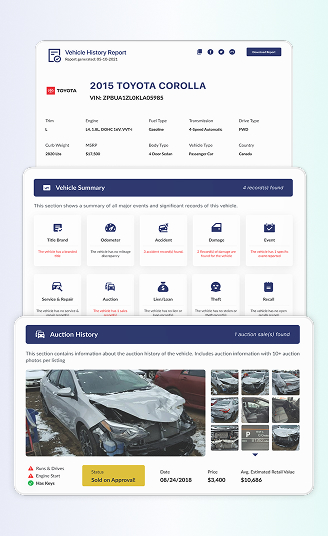Many factors influence the value of a used car, but age and mileage are the most significant. When a vehicle leaves the dealership, it begins to lose value due to depreciation caused by wear and tear, aging, and increasing mileage. Mileage has the most significant impact, as higher mileage often means more use, leading to faster depreciation.
The more you drive, the less your car is worth. For example, if you buy a new car for $50,000, the car will depreciate as soon as it leaves the dealership, and if you try to resell it, it will probably be priced at around $48,000.
How much do cars lose value with each mile driven? Understanding depreciation is important for both buyers and sellers. Buyers can use this information to assess if a high-mileage car is worth the price, while sellers can set a fair asking price based on wear and tear. Knowing how mileage affects value helps buyers avoid overpaying and allows sellers to justify their pricing.
Mileage, Model, and More: What Drives Car Depreciation
Not all miles are equal when it comes to mileage records. The car loses value depending on its miles and age.
New cars experience an extreme value drop in the first year they are sold; on average, they lose 15% to 20% of their value, varying depending on the brand and model. After five years, it may only be worth about 40% of its original price. This decline in value over time is known as depreciation.
However, these numbers estimate many factors determining how much value you will lose the car over time. Aside from the mileage, other factors could affect the car’s value.
Model Year
People are willing to pay for the full MSRP for a brand-new car. Like all other machines, cars break down over time, while people rely on newly released vehicles with the latest technology.
Make and Model
Good luck if you own a popular model from a certain manufacturer. Supply and demand are involved—when more buyers are interested in your vehicle, its value naturally increases.
Mileage and Maintenance Records
The mileage and maintenance records determine the car’s resale value. Cars with fewer mileage records combined with excellent maintenance records hold more value than cars with higher mileage and rarely need maintenance to keep up with the overall performance.
Clean Accident Records
Used cars with no history of accidents fetch higher resale prices because the buyers know that vehicles with historical records tend to be unsafe. Check the accident history record of the used car you are about to buy to ensure that the car is in good shape and has a clean title record.
How Much Does a Car Depreciate After 100 Miles?
After the steep initial drop in value, car depreciation tends to slow down, typically decreasing by 10–15% per year. Some experts estimate that depreciation costs around $0.08 per mile, but depreciation is more commonly measured over time than per mile.
If you want to determine your car’s depreciation accurately, relying on broad percentage estimates may not be the best approach. Different vehicles depreciate at different rates.
Tips to Slow Down Car’s Depreciation
While depreciation is unavoidable, there are ways to minimize depreciation of your vehicle. Here are the tips you can follow to minimize depreciation.
If Possible, Drive Less
Reducing a car’s mileage helps maintain its resale value, as high mileage is a key factor in depreciation. You can use public transportation, carpool, or work remotely to avoid unnecessary wear and tear on your vehicle.
Keep up With Maintenance
Routine servicing, including complying with the maintenance schedule, ensures the vehicle stays in good condition. A well-maintained vehicle not only runs better but also holds its value longer.
Choose a Reliable Car
Some cars depreciate lower than the other makes due to their durability and performance. Before purchasing, research models known for strong resale value, such as Toyota or Honda, as they often retain their worth better over time.
Avoid Unnecessary Modifications
Custom paint jobs, extreme tuning, or aftermarket parts often depreciate the car faster since most buyers prefer the original-built car without any modifications. Keeping your car as it was makes it easier to resell the vehicle.
Sell at the Right Time
Depreciation happens in stages, with significant drops occurring at major mileage milestones. Selling before hitting benchmarks like 60,000 or 100,000 miles can help you get a higher price for your vehicle before depreciation accelerates.
In Conclusion, Car Depreciation Per Mile Matters
In reality, mileage is one main factor contributing to a car’s depreciation. While a vehicle loses its value when the mileage hits 10,000 miles, depreciation per mile decreases over time. By understanding how much a car depreciates after 100 or even 100,000 miles, car owners should decide whether to repair or sell the vehicle.
If you plan to buy a used car, get yourself a vehicle history report to ensure that you get the actual information about the vehicle.
In addition, if you plan to sell the vehicle, you must ensure that you don’t drive it recklessly and comply with the maintenance requirements and schedule to maintain its performance and safety.
FAQ About How Mileages Affect Your Car’s Value
When determining what mileage is too high for a used car, the answer varies as there are no rules to determine the exact number. However, 200,000 miles sets the limit as the highest miles on a used car.
About 1% of the car’s value when new for every 1000 miles. It’s a rough estimate, but for the first 5–7 years, cars generally depreciate about 10% per year, at about 12k miles per year. 1% is a pretty good approximation.
After about 40,000 miles, a car depreciates slowly and steadily. However, it dramatically depreciates during the first 20,000 miles.
After about 40,000 miles, a car depreciates slowly and steadily. However, it dramatically depreciates during the first 20,000 miles.









